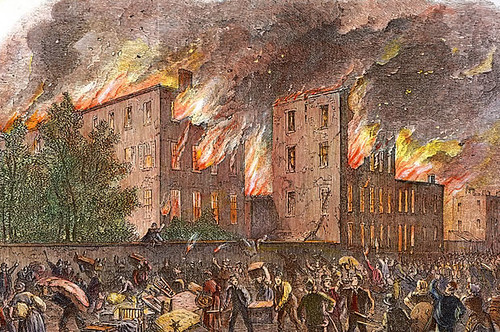Opponents of conscription begin three days of rioting in New York City.
On July 13, 1863, as the second day of a new military draft lottery in New York City got underway, demonstrations broke out across the city in what began as an organized opposition to the first federally mandated conscription laws in the nation’s history, but soon morphed into a violent uprising against the city’s wealthy elite; its African-American residents; and the very idea of the Civil War itself. The New York City Draft Riots, which would wreak havoc on the city for four days and remain the largest civilian insurrection in American history, exposed the deep racial, economic and social divides that threatened to tear the nation’s largest city apart in the midst of the American Civil War.
Thanks to its status as the business capital of the United States, New York City was a deeply divided city at the start of the Civil War in April 1861. Its merchants and financial institutions were loath to lose their southern business and the city’s then-mayor, Fernando Wood, had called for the city to secede from the Union. Meanwhile, to the city’s poorer citizens, the war increasingly came to be seen as benefitting only the rich, as the coffers of the city’s elites filled with the financial spoils of battle and the conflict became known as a “rich man’s war, poor man’s battle.” The passage of the nation’s first military draft act, in March 1863, only worsened the situation. Not only did it allow men to buy their way out of military service by paying a commutation fee of $300 , it also exempted blacks from the draft, as they were not yet considered American citizens. Opposition to the draft was widespread across the North, and in New York, some of the loudest critics of the bill could be found in city government, as politicians railed against the legality of the bill and its impact on the city’s working class poor.

